Early Verdict
The Samsung Galaxy Watch 4 Classic is a standard premium smartwatch, and it has both the perks and the drawbacks of such devices. It’s hardy and good-looking, with loads of useful features, and a rotating bezel that works especially well for navigating menus. However, it costs a lot, and won’t sit well on all wrists, even average-sized ones.
Pros
- +
Rotating bezel works well
- +
Plenty of health features
Cons
- -
Pricier than sibling
- -
Doesn’t fit all wrists
Why you can trust TechRadar
When the Samsung Galaxy Watch 4 launched it wasn’t joined by the Watch Active 4, as we’d expected, but rather the Watch 4 Classic, which uses the same software as its sibling, but has a more premium design, and a higher price.
The main reason you’d choose this watch over the non-Classic version is its rotating physical bezel, which you can use to scroll smoothly through menus to navigate the watch; the standard-issue Watch 4 has a haptic version of this feature which doesn’t work nearly as well.
The Galaxy Watch 4 and Watch 4 Classic also debut a new version of Wear OS, Google’s smartwatch operating system, which Samsung had a hand in designing. This means you’re getting access to the Play Store, and to both Google’s and Samsung’s fitness apps.
It’s not a perfect watch though, and it has the same issues as many similar wearables. The design is big and bulky, and it didn’t sit snugly on our wrist, due to some band issues we’ll explore further on. As a result the Watch 4 Classic jiggled about when we moved our wrists, and wasn’t especially comfortable.
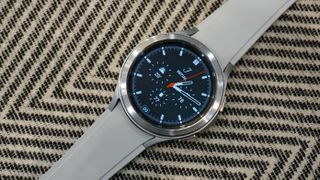
The price is rather high too. Sure, you’re buying a premium device, but several Chinese brands offer similarly well-made and feature-packed watches for much less money.
Samsung Galaxy Watch 4 Classic release date and price
The Classic version of Samsung’s new smartwatch comes in two sizes: 42mm and 46mm models and both come in Bluetooth or LTE options.
In the UAE, we only have pricing for the Bluetooth version as of now which is AED 1,339 for the 42mm model and 1,449 for the 46mm model.
The Galaxy Watch 4 Classic was unveiled on August 11, with pre-orders open now – the official release date is August 27.
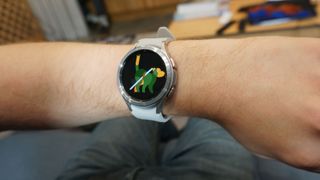
Design and display
As we’ve mentioned, the Samsung Galaxy Watch 4 Classic has bigger screen options than its standard counterpart; throw in the large rotating bezel, and it’s a significantly bigger device.
The watch is 11mm thick and weighs around 50g depending on which size you opt for, so it’s a chunky monkey, and it doesn’t exactly sit comfortably on this wrist as a result.
Unlike on most other watches, where you can adjust the angle of the strap relative to the body, on the Watch 4 Classic (and the standard Watch 4), the straps can only protrude straight out from the sides of the body, which results in a sizable gap between the strap and your wrist on either side of the body; see the image of this issue on the standard model below – and we'd consider our wrists to be pretty averagely size
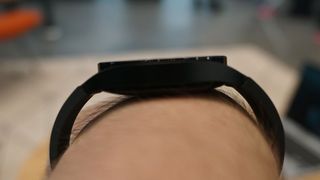
The straps are replaceable, so it’s likely that Samsung will offer different versions made of various materials, which means it’s possible that you’ll be able to buy replacements that sit more easily on your wrist – but we weren’t fans of the bands on the review models we tried.
The body of the watch is made of stainless steel, so it feels pretty hardy, and there are two buttons on the left side. The top one is for returning to the main watch face when you’re in the menus (though it doesn’t bring up the app menu when you press it from the watch face, unlike basically every other smartwatch in existence, which threw us).
We found the rotating bezel a treat to use – it gives a satisfying ‘click’ as you turn it, and it was a lot easier to use than the swipe equivalent on the standard Watch 4. Is it worth the extra cost, though? We’re not too sure.
Specs and software
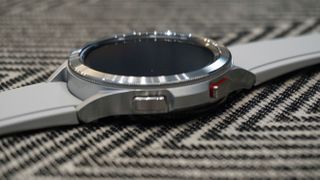
The Samsung Galaxy Watch 4 Classic uses the company’s own Exynos W920 chipset, which is paired with 1.5GB of RAM. What does this chipset bring to the table? Well, not much that we haven’t seen before – the watch feels pretty smooth to navigate, and will likely run multiple apps well. There’s also 16GB storage, which is quite a bit for a watch.
The chipset has the benefit of making the always-on display less power-hungry thanks to some optimizations, and the fact that it has a separate sub-processor that handles this feature. This technique isn’t new to smartwatches, with Qualcomm’s Wear 4100 series doing the same, and hopefully it’ll mean the watch lasts longer when you’re not using the display.
This watch, along with the standard Galaxy Watch 4, marks the debut of WearOS 3, a new version of Google’s smartwatch operating system designed in cooperation with Samsung. It’s certainly less wooden-feeling than the last version, with tiles now genuinely useful, and with lots of options and plenty of apps, but we had some issues too.
First, the app menu presents every option without a name label. We found ourselves staring at a host of app icons with no idea what most of them did, which was really confusing, although if you buy the watch, you’ll probably get used to these.

Second, navigating this device is unlike navigating basically every other smartwatch. Instead of pressing the top button to open the app menu, you have to swipe from the main watch face, which is a little less convenient; in other areas though, the watch is easier to navigate than rivals, thanks to the bezel. You win some, you lose some.
WearOS 3 is something we’ll need to test in depth, both on the Galaxy Watch 4 Classic and on future smartwatches. It’s a decent open-source OS, with lots of options for third-party apps, but it’s a big drain on battery life, and Google seemingly gave up supporting version 2 for most of its lifespan.
Fitness and battery life
We’ve only tested the Galaxy Watch 4 Classic for a brief amount of time, so we haven’t yet had the chance to try out any of its fitness features; so while we’ll talk about some of them below, we can’t account for how well they work.
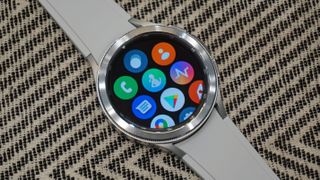
There does appear to be a wide range of health features, which you can access by swiping through the tiles, with heart rate, sleep, stress, blood oxygen and body composition measuring; we tested the latter, and it was fiddly to get working, though the stat it returned for us looked to be within the realms of possibility.
In terms of workouts you’ve got all the basics, like running, cycling and swimming, and they’ll return all the metrics you’d expect like heart rate, time and distance, with built-in GPS ensuring that location data is fairly accurate. There’s also a selection of more niche sports, such as yoga and rowing. The list includes lots of individual exercises like squatting, leg pressing and crunches, which is pretty rare in the smartwatch world.

Don’t expect a long list of super-niche sports modes like skiing, surfing and dancing, as some smartwatches offer, though. It seems that Samsung has focused its watches on offering fewer modes, but making sure that those modes work really well.
Since we only tested the watch for a limited amount of time, we didn’t get to test its battery life, but Samsung’s wearables tend to have okay-ish staying power – i.e. a couple of days. That’s good compared to the paltry one-day lifespan of Apple Watches or most Wear OS watches, although it pales compared to the fortnight, or even month, that some other smartwatches can last for.
The 42mm watch has a 247mAh battery while the 46mm model has a 361mAh power pack, so despite the different screen sizes we’d expect them to last roughly the same amount of time.
Early verdict
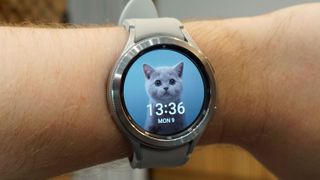
The Samsung Galaxy Watch 4 Classic promises to be a useful smartwatch, with wide app compatibility, decent battery life and plenty of gym workout modes.
The things that make the Classic watch distinct from the standard version are hit-and-miss, though. While the rotating bezel is really nice to use, the watch doesn’t sit well on the wrist, and doesn’t offer much to justify its high price tag.
There are also some big questions that we’ll need further time and testing to answer. The watch’s battery life, its durability in real-world use, and whether or not Google decides to actually support WearOS this time, will ultimately determine the Classic’s value over time.
So if we were you, we’d consider the standard watch alongside this one, and weigh up which is more worthwhile for you. Oh, and consider the competition too, because there are plenty of affordable smartwatches from Chinese brands that rival Samsung’s uncompetitively-priced wearables in terms of specs and features.

Tom Bedford was deputy phones editor on TechRadar until late 2022, having worked his way up from staff writer. Though he specialized in phones and tablets, he also took on other tech like electric scooters, smartwatches, fitness, mobile gaming and more. He is based in London, UK and now works for the entertainment site What To Watch.
He graduated in American Literature and Creative Writing from the University of East Anglia. Prior to working on TechRadar, he freelanced in tech, gaming and entertainment, and also spent many years working as a mixologist. He also currently works in film as a screenwriter, director and producer.
What is a hands on review?
Hands on reviews' are a journalist's first impressions of a piece of kit based on spending some time with it. It may be just a few moments, or a few hours. The important thing is we have been able to play with it ourselves and can give you some sense of what it's like to use, even if it's only an embryonic view. For more information, see TechRadar's Reviews Guarantee.

